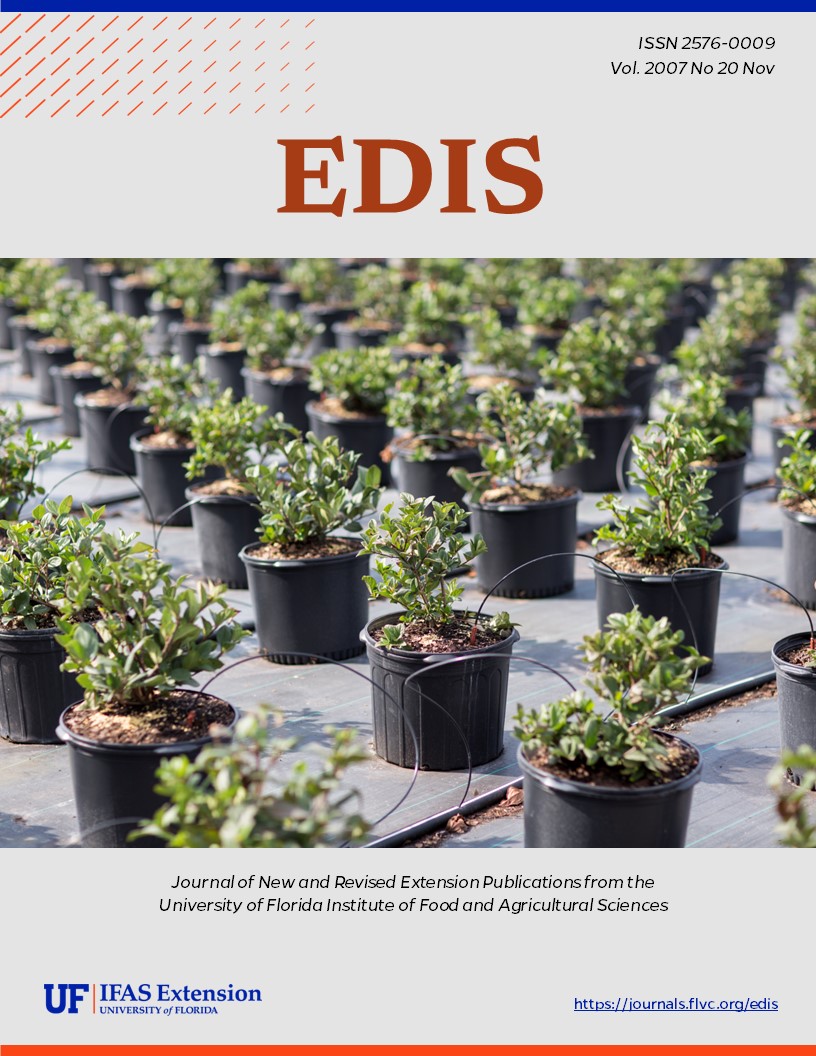Abstract
FOR-119, a 13-page full color fact sheet by Mary L. Duryea and Eliana Kampf, is part of the Urban Forest Hurricane Recovery Program series. It presents the research and methodology that lead to lists of relative wind resistance for coastal plain tree species. Includes recommendations for selecting and establishing trees for a healthier and more wind-resistant urban forest. Published by the UF School of Forest Resources and Conservation, September 2007.
FOR119/FR174: Selecting Coastal Plain Species for Wind Resistance (ufl.edu)
References
Barry, P.J., C. Doggett, R.L. Anderson, and K.M. Swain, Sr. 1993. How to evaluate and manage storm-damaged forest areas. Management Bulletin R8-MB 63 of the USDA Forest Service, Southern Region. Atlanta, GA. 11 pp.
Batista, W.B. and W.J. Platt. 2003. Tree population responses to hurricane disturbance: syndromes in a south-eastern USA old-growth forest. Ecology 91:197-212.
Duryea, M.L., G.M. Blakeslee, W.G. Hubbard, and R.A. Vasquez. 1996. Wind and trees: A survey of homeowners after Hurricane Andrew. J. Arboric. 22(1):44-50.
Duryea, M.L. 1997. Wind and trees: Surveys of tree damage in the Florida Panhandle after Hurricanes Erin and Opal. Circular 1183 of the University of Florida Cooperative Extension Service (http://edis.ifas.ufl.edu/). Gainesville, FL. 7 pp.
Duryea, M.L., E. Kampf, and R.C. Littell. 2007. Hurricanes and the Urban Forest: I. Effects on Southeastern U.S. Coastal Plain Tree Species. Arboric. & Urban Forestry 33(2):83-97.
Everham III, E.M. and N.V.L. Brokaw. 1996. Forest damage and recovery from catastrophic wind. The Botanical Review 62:113-185. https://doi.org/10.1007/BF02857920
Fox, A.M., D.R. Gordon, J.A. Dusky, L. Tyson, and R.K. Stocker. 2005. IFAS assessment of the status of non-native plants in Florida's natural areas. SS-AGR-225 of the University of Florida, IFAS Cooperative Extension Service. http://plants.ifas.ufl.edu/assessment/ Gainesville, FL. 27 pp.
Francis, J.K. and A.J.R. Gillespie. 1993. Relating gust speed to tree damage in Hurricane Hugo, 1989. J. Arboric. 19:368-372.
Glitzenstein, J.S. and P.A. Harcombe. 1988. Effects of the December 1983 tornado on forest vegetation of the Big Thicket, southeast Texas, USA. For. Ecol. Managem. 25:269-290. https://doi.org/10.1016/0378-1127(88)90092-8
Gresham, C.A., T.M. Williams, and D.J. Lipscomb. 1991. Hurricane Hugo wind damage to Southeastern U.S. coastal forest tree species. Biotropica 23(4) (Part A. Special Issue: Ecosystem, Plant, and Animal Responses to Hurricanes in the Caribbean):420-426. https://doi.org/10.2307/2388261
King, H.C. 1945. Notes on the three cyclones in Mauritius in 1945: Their effect on exotic plantations, indigenous forest and on some timber buildings. Empire Forest. J. 24: 192-195.
Kormanik, P. 1990. Liquidambar styraciflua, sweetgum. In: Silvics of North America: 2. Hardwoods. Burns, R. M., and B. H. Honkala, Tech. Coords. (http://www.na.fs.fed.us/spfo/pubs/silvics_manual/table_of_contents.htm) Agriculture Handbook 654 Vol. 2 of the U.S.D.A. Forest Service, Washington, DC. 877 pp.
Swain, K.M. 1979. Minimizing timber damage from hurricanes. S. Lumberman 239:107-109.
Touliatos, P. and E. Roth. 1971. Hurricanes and trees: Ten lessons from Camille. J. For. 285-289.
Webb, S.L. 1989. Contrasting windstorm consequences in two forests, Itasca State Park, Minnesota. Ecology 70(4):1167-1180. https://doi.org/10.2307/1941384

